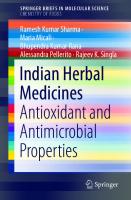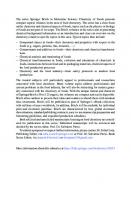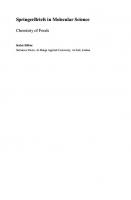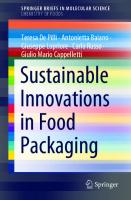Indian Herbal Medicines: Antioxidant and Antimicrobial Properties (SpringerBriefs in Molecular Science) 303080917X, 9783030809171
This book discusses the scope and limitations of the antimicrobial and antioxidant properties of foods as medicines or m
130 22 2MB
English Pages 62 [61] Year 2021
Contents
About the Authors
1 Relevance of Ayurveda. Therapy of Holistic Application and Classification of Herbs
1.1 Introduction: Efficacy of Herbs and Synthetic Drugs Facing Challenges
1.2 Observation: Limitations of Herbs, Synthetic Drugs and Active Ingredients Isolated
1.3 Hypothesis: Herbs Holistically More Effective Than Isolated Active Ingredients
1.4 Studies in the Context of Hypotheses
1.5 Holistic Classification and Application of Herbs in Charak Samhita
1.5.1 Sweet Taste
1.5.2 Sour Taste
1.5.3 Salty Taste
1.5.4 Pungent Taste
1.5.5 Bitter Taste
1.5.6 Astringent Taste
1.5.7 Combined Tastes
1.6 Efficacy of Extracts of Herbs in the Light of Antimicrobial Susceptibility Tests
1.7 Discussion and Conclusion: Ayurveda is Relevant
References
2 Indian Herbal Extracts as Antimicrobial Agents
2.1 Introduction to Herbal Extracts and Antimicrobial Properties
2.2 Active Principles from Vegetable Organisms Against Microbial Growth
2.3 Herbal Extracts and Antimicrobial Properties. The Indian Perspective
2.4 Herbal Extracts and Antimicrobial Properties. Conclusions
References
3 Indian Herbal Extract as Antioxidant Agents
3.1 Introduction to Herbal Extracts as Antioxidant Remedies
3.2 Antioxidant Products and Herbal Extracts … in India
3.3 Antioxidant Products and Herbal Extracts in India and Abroad. Conclusions
References
4 Natural Antioxidant Agents for Treatment of Metabolic Diseases and Disorders
4.1 Natural Antioxidants Today. Why?
4.2 Natural Antioxidants Today. Conclusions and Perspectives
References
Recommend Papers

- Author / Uploaded
- Ramesh Kumar Sharma
- Maria Micali
- Bhupendra Kumar Rana
- Alessandra Pellerito
- Rajeev K. Singla
File loading please wait...
Citation preview
SPRINGER BRIEFS IN MOLECULAR SCIENCE CHEMISTRY OF FOODS
Ramesh Kumar Sharma · Maria Micali · Bhupendra Kumar Rana · Alessandra Pellerito · Rajeev K. Singla
Indian Herbal Medicines Antioxidant and Antimicrobial Properties 123
SpringerBriefs in Molecular Science
Chemistry of Foods Series Editor Salvatore Parisi, Lourdes Matha Institute of Hotel Management and Catering Technology, Thiruvananthapuram, Kerala, India
The series Springer Briefs in Molecular Science: Chemistry of Foods presents compact topical volumes in the area of food chemistry. The series has a clear focus on the chemistry and chemical aspects of foods, topics such as the physics or biology of foods are not part of its scope. The Briefs volumes in the series aim at presenting chemical background information or an introduction and clear-cut overview on the chemistry related to specific topics in this area. Typical topics thus include: – Compound classes in foods—their chemistry and properties with respect to the foods (e.g. sugars, proteins, fats, minerals, …) – Contaminants and additives in foods—their chemistry and chemical transformations – Chemical analysis and monitoring of foods – Chemical transformations in foods, evolution and alterations of chemicals in foods, interactions between food and its packaging materials, chemical aspects of the food production processes – Chemistry and the food industry—from safety protocols to modern food production The treated subjects will particularly appeal to professionals and researchers concerned with food chemistry. Many volume topics address professionals and current problems in the food industry, but will also be interesting for readers generally concerned with the chemistry of foods. With the unique format and character of SpringerBriefs (50 to 125 pages), the volumes are compact and easily digestible. Briefs allow authors to present their ideas and readers to absorb them with minimal time investment. Briefs will be published as part of Springer’s eBook collection, with millions of users worldwide. In addition, Briefs will be available for individual print and electronic purchase. Briefs are characterized by fast, global electronic dissemination, standard publishing contracts, easy-to-use manuscript preparation and formatting guidelines, and expedited production schedules. Both solicited and unsolicited manuscripts focusing on food chemistry are considered for publication in this series. Submitted manuscripts will be reviewed and decided by the series editor, Prof. Dr. Salvatore Parisi. To submit a proposal or request further information, please contact Dr. Sofia Costa, Publishing Editor, via [email protected] or Prof. Dr. Salvatore Parisi, Book Series Editor, via [email protected] or [email protected]
More information about this subseries at http://www.springer.com/series/11853
Ramesh Kumar Sharma · Maria Micali · Bhupendra Kumar Rana · Alessandra Pellerito · Rajeev K. Singla
Indian Herbal Medicines Antioxidant and Antimicrobial Properties
Ramesh Kumar Sharma Food safety consultant Tilam Sangh Rajasthan Bikaner, Rajasthan, India
Maria Micali Food safety consultant, Messina, Italy Alessandra Pellerito Food safety consultant, Palermo, Italy
Bhupendra Kumar Rana Quality and Accreditation Institute Noida, Uttar Pradesh, India Rajeev K. Singla Institutes for Systems Genetics West China Hospital, Sichuan University Chengdu, Sichuan, China
ISSN 2191-5407 ISSN 2191-5415 (electronic) SpringerBriefs in Molecular Science ISSN 2199-689X ISSN 2199-7209 (electronic) Chemistry of Foods ISBN 978-3-030-80917-1 ISBN 978-3-030-80918-8 (eBook) https://doi.org/10.1007/978-3-030-80918-8 © The Author(s), under exclusive license to Springer Nature Switzerland AG 2021 This work is subject to copyright. All rights are solely and exclusively licensed by the Publisher, whether the whole or part of the material is concerned, specifically the rights of translation, reprinting, reuse of illustrations, recitation, broadcasting, reproduction on microfilms or in any other physical way, and transmission or information storage and retrieval, electronic adaptation, computer software, or by similar or dissimilar methodology now known or hereafter developed. The use of general descriptive names, registered names, trademarks, service marks, etc. in this publication does not imply, even in the absence of a specific statement, that such names are exempt from the relevant protective laws and regulations and therefore free for general use. The publisher, the authors and the editors are safe to assume that the advice and information in this book are believed to be true and accurate at the date of publication. Neither the publisher nor the authors or the editors give a warranty, expressed or implied, with respect to the material contained herein or for any errors or omissions that may have been made. The publisher remains neutral with regard to jurisdictional claims in published maps and institutional affiliations. This Springer imprint is published by the registered company Springer Nature Switzerland AG The registered company address is: Gewerbestrasse 11, 6330 Cham, Switzerland
Contents
1 Relevance of Ayurveda. Therapy of Holistic Application and Classification of Herbs . . . . . . . . . . . . . . . . . . . . . . . . . . . . . . . . . . . . . . . 1.1 Introduction: Efficacy of Herbs and Synthetic Drugs Facing Challenges . . . . . . . . . . . . . . . . . . . . . . . . . . . . . . . . . . . . . . . . . . . . . . . . . 1.2 Observation: Limitations of Herbs, Synthetic Drugs and Active Ingredients Isolated . . . . . . . . . . . . . . . . . . . . . . . . . . . . . . . . . . . . . . . . . . 1.3 Hypothesis: Herbs Holistically More Effective Than Isolated Active Ingredients . . . . . . . . . . . . . . . . . . . . . . . . . . . . . . . . . . . . . . . . . . . 1.4 Studies in the Context of Hypotheses . . . . . . . . . . . . . . . . . . . . . . . . . . . 1.5 Holistic Classification and Application of Herbs in Charak Samhita . . . . . . . . . . . . . . . . . . . . . . . . . . . . . . . . . . . . . . . . . . . . . . . . . . . . 1.5.1 Sweet Taste . . . . . . . . . . . . . . . . . . . . . . . . . . . . . . . . . . . . . . . . . . 1.5.2 Sour Taste . . . . . . . . . . . . . . . . . . . . . . . . . . . . . . . . . . . . . . . . . . . 1.5.3 Salty Taste . . . . . . . . . . . . . . . . . . . . . . . . . . . . . . . . . . . . . . . . . . . 1.5.4 Pungent Taste . . . . . . . . . . . . . . . . . . . . . . . . . . . . . . . . . . . . . . . . 1.5.5 Bitter Taste . . . . . . . . . . . . . . . . . . . . . . . . . . . . . . . . . . . . . . . . . . . 1.5.6 Astringent Taste . . . . . . . . . . . . . . . . . . . . . . . . . . . . . . . . . . . . . . 1.5.7 Combined Tastes . . . . . . . . . . . . . . . . . . . . . . . . . . . . . . . . . . . . . . 1.6 Efficacy of Extracts of Herbs in the Light of Antimicrobial Susceptibility Tests . . . . . . . . . . . . . . . . . . . . . . . . . . . . . . . . . . . . . . . . . . 1.7 Discussion and Conclusion: Ayurveda is Relevant . . . . . . . . . . . . . . . . References . . . . . . . . . . . . . . . . . . . . . . . . . . . . . . . . . . . . . . . . . . . . . . . . . . . . . . 2 Indian Herbal Extracts as Antimicrobial Agents . . . . . . . . . . . . . . . . . . . 2.1 Introduction to Herbal Extracts and Antimicrobial Properties . . . . . . 2.2 Active Principles from Vegetable Organisms Against Microbial Growth . . . . . . . . . . . . . . . . . . . . . . . . . . . . . . . . . . . . . . . . . . . . . . . . . . . . 2.3 Herbal Extracts and Antimicrobial Properties. The Indian Perspective . . . . . . . . . . . . . . . . . . . . . . . . . . . . . . . . . . . . . . . . . . . . . . . . . 2.4 Herbal Extracts and Antimicrobial Properties. Conclusions . . . . . . . . References . . . . . . . . . . . . . . . . . . . . . . . . . . . . . . . . . . . . . . . . . . . . . . . . . . . . . .
1 2 5 8 8 9 10 18 19 19 21 21 22 23 24 25 31 32 34 35 36 36
v
vi
Contents
3 Indian Herbal Extract as Antioxidant Agents . . . . . . . . . . . . . . . . . . . . . . 3.1 Introduction to Herbal Extracts as Antioxidant Remedies . . . . . . . . . . 3.2 Antioxidant Products and Herbal Extracts … in India . . . . . . . . . . . . . 3.3 Antioxidant Products and Herbal Extracts in India and Abroad. Conclusions . . . . . . . . . . . . . . . . . . . . . . . . . . . . . . . . . . . . . . . . . . . . . . . . References . . . . . . . . . . . . . . . . . . . . . . . . . . . . . . . . . . . . . . . . . . . . . . . . . . . . . .
41 42 44 44 45
4 Natural Antioxidant Agents for Treatment of Metabolic Diseases and Disorders . . . . . . . . . . . . . . . . . . . . . . . . . . . . . . . . . . . . . . . . . . . . . . . . . . . 4.1 Natural Antioxidants Today. Why? . . . . . . . . . . . . . . . . . . . . . . . . . . . . . 4.2 Natural Antioxidants Today. Conclusions and Perspectives . . . . . . . . References . . . . . . . . . . . . . . . . . . . . . . . . . . . . . . . . . . . . . . . . . . . . . . . . . . . . . .
49 50 52 52
About the Authors
Ramesh Kumar Sharma is currently Food Safety Consultant and Scientific Writer 2000 onwards, having worked in past as Chemist in different roles including: Fellow, Science Education Centre, University of Rajasthan, Jaipur 1978–1979; Chief Investigator, Play Material Project—UNICEF project. Toxins and Contaminants in Indian Food Products is the title of a book, written by him in co-authorship with Salvatore Parisi, published by Springer. Maria Micali is an experienced Author in the field of food science and technology, with particular focus in chemistry, microbiology and hygiene. She obtained a Ph.D. in food hygiene from the University of Messina, Italy. She is also Lecturer in different sectors, including professional training. Her published works include The Chemistry of Thermal Food Processing Procedures (2016) and Traceability in the Cheesemaking Field. The Regulatory Ambit and Practical Solutions (2016). Bhupendra Kumar Rana is a seasoned quality professional, extensively worked in healthcare quality and improvement. He obtained a Ph.D. in Biochemistry from Banaras Hindu University, Varanasi, India. From the past 20 years, he has been pioneer in accreditation standards, currently being CEO of Quality & Accreditation Institute (QAI) and International Expert/Consultant for the World Health Organization, the World Bank, Asian Development Bank, USAID and several Ministries of Health. He has published 12 research papers and several chapters in books on antimicrobial activity of plant products and healthcare quality. Alessandra Pellerito is a Biologist graduated at the University of Bologna, Italy (2013), with full marks (110/100 cum laude) after the initial B.Sc. in Biology (Palermo, Italy). After a short period spent in the UK, she moved to Germany (Magdeburg). At present, she works as Food Consultant in the private sector (Italy). Her first articles on food chemistry have been published by the Journal of AOAC International. Her first book is Food Sharing—Chemical Evaluation of Durable Foods (Springer).
vii
viii
About the Authors
Rajeev K. Singla works as Assistant Researcher in Institutes for Systems Genetics, West China Hospital of Sichuan University, Chengdu (Sichuan), China. He has previously worked as Assistant Professor in K. R. Mangalam University (Gurugram, India). He has obtained his doctorate degree from University of Delhi, India, in the field of natural product chemistry. So far, he has published 45 SCI articles with cumulative impact factor of 131. He is also Founder and Chief Editor of Indo Global Journal of Pharmaceutical Sciences (UGC-CARE, CNKI, and CrossRef linked Journal) and Review Editor of Frontiers in Chemistry and Frontiers in Oncology. He has so far reviewed 249 articles for 43 journals. One of his most recent publications is Analytical Methods for the Assessment of Maillard Reactions in Foods (Springer).
Chapter 1
Relevance of Ayurveda. Therapy of Holistic Application and Classification of Herbs
Abstract The efficacy of herbal extracts has been often questioned due to presence of natural toxin loads like alkaloids and terpenes as well as farm-level applied synthetic crop protection chemicals called pesticides, if any, and fungal toxins like aflatoxins. In addition, the efficacy of synthetically prepared drugs is challenged on account of containing process by-products and exerting side effects. The midway therefore emerges as isolation of active ingredients from herbs or any food source. On the other side, Ayurveda underlines holistic approaches in development of medicine in which organic herbal powders—with or without aqueous herbal extracts—are utilised as drug ingredients. It has been observed that herbs holistically are more effective than the active ingredients isolated from them, if side effects too are considered along with time taken in recuperation. In general, the antimicrobial susceptibility tests do not always confirm the same therapeutic action of drugs (against particular microbial) corresponding to particular disease for which those are traditionally known and holistically underlined in Ayurveda. It might be concluded that the therapeutic system Ayurveda is still quite relevant. Keywords Active ingredient · Allopathy · Antimicrobial activity · Ayurveda · Kapha · Pitta · Vata
Abbreviations AI AST BHA CCRAS GSFA CODEX STAN COVID-19 DP DE F&B
Active ingredient Antimicrobial susceptibility test Butyl hydroxylanisol Central Council for Research in Ayurvedic Sciences Codex General Standard for Food Additives Codex standard COronaVIrus Disease19 Degree of polymerisation Dextrose equivalent Food and beverage
© The Author(s), under exclusive license to Springer Nature Switzerland AG 2021 R. K. Sharma et al., Indian Herbal Medicines, Chemistry of Foods, https://doi.org/10.1007/978-3-030-80918-8_1
1
2
1 Relevance of Ayurveda. Therapy of Holistic Application …
FSSAI MW RS SARS-CoV-2 TBHQ
Food Safety and Standards Authority of India Molecular weight Relative sweetness Severe acute respiratory syndrome coronavirus 2 T-butyl hydroquinone
1.1 Introduction: Efficacy of Herbs and Synthetic Drugs Facing Challenges The modern medical science focuses on chemical compounds, called drugs, to be taken individually or in combination to fight against disease. Such compounds are either synthetically prepared or isolated from natural food or herb source. Drugs are classified as per their specific action or efficacy against ailment. Aspirin and paracetamol are called pain relievers; diazepam and alprazolam are termed as anti-anxiety drugs; diphenylhydantoin and phenobarbital are referred as anti-epileptics; levodopa and amantadine are known as antiparkinsonism; clonidine and guanethidine are recognised as antihypertensive. Besides such a classification of drugs based on their antidisease action, there are also drugs fighting against microbial—bacteria, fungi and viruses—individually known as antibacterial, antifungal and antiviral compounds. These compounds are collectively called antibiotics. Despite applying the broad network of instrumental diagnosis and chemotherapeutic cure system, the modern allopath physicians, however, use traditional medicine too in the cases of ailments such as diseases concerning lungs (respiration) heart, liver, nervous system and joint illnesses (pneumonia, hypertension, hepatitis, memory loss and arthritis) (Dorsher and McIntosh 2011). In detail, the following diseases have been reported to be treated by means of allopathic systems, methods and traditional procedures even in recent times with concern to the pandemics by ‘COronaVIrus Disease 19’ (COVID-19) or ‘severe acute respiratory syndrome coronavirus 2’ (SARS-CoV-2): (1)
Lung diseases (Ali and Alharbi 2020; Broor et al. 2001; Bussmann and Glenn 2010; Lin et al. 2014; Rigat et al. 2013; Ullman and Frass 2010; Younis et al. 2018; Zhang et al. 2020a b; Wang et al. 2020). In these situations, the concerned treatments include oxygen use and infusion of intravenous fluids with life support. In addition, Unani plant-based products and Ayurvedic procedures are often reported to show antiviral properties (Kim et al. 2010; Li et al. 2005, 2016). In addition, the Indian Ministry of Ayush has recently communicated that AYUSH 64, a polyherbal formulation developed by the Central Council for Research in Ayurvedic Sciences (CCRAS), has been found to be effective in treatment of mild-to-moderate cases of COVID-19 infection (PIB 2021). The drug, named AYUSH-64 and initially developed for Malaria in 1980, has been reproposed for COVID-19. AYUSH 64 includes Alstonia scholaris (aqueous
1.1 Introduction: Efficacy of Herbs and Synthetic Drugs Facing …
(2)
(3) (4)
3
bark extract), Picrorhiza kurroa (aqueous rhizome extract), Swertia chirata (aqueous extract of whole plant) and Caesalpinia crista (fine-powdered seed pulp) Heart-related disorders (Arthur et al. 2006; Davidson et al. 2003; de Souza Balbueno et al. 2020; Kim et al. 2010; Kumar et al. 2017; Li et al. 2005; Maron 2015; Mashour et al. 1998; Sharma and Rana 2018; Sharma et al. 2017, 2019). With concern to India, a remarkable part of heart-related diseases— atherosclerosis, coronary artery illness, hypertension and myocardial infarction—are reported to be often studied when speaking of public safety. In this ambit, the promotion of Ayurveda, Unani, Siddha and alternative/traditional therapies is extremely promoted and encouraged (Mahalle et al. 2012) Liver diseases (Bhatt and Bhatt 1996; Govind 2011; Rajaratnam et al. 2014; Yang et al. 2002; Xiong and Guan 2017) Illnesses of the human nervous system (Bussmann et al. 2010; Chen et al. 2007; Dorsher and McIntosh 2011; Pandian et al. 2006; Ven Murthy et al. 2010).
The well-known traditional Ayurvedic drugs for treatment of these ailments normally include the major herbs Emblica officinalis (amla), Commiphora mukul (guggal), Capparis spinosa (himsra) with Cichorium intybus (chicory), Centella asiatica (brahmi) and Commiphora mukul with calcined conch (shankh bhasm), respectively. These herbs are also becoming part and parcel of some medicine prescribed by allopath physicians. The reason for adopting Ayurvedic herbal medicine seems to be consideration of side effects, when the patient undergoes prolonged chemotherapy. There are several cases when overmedication becomes the treatment pathway for a patient. For example, the patient feels partial improvement with intake of tablets, in a few cases of arthritis, particularly spondylitis: anti-inflammatory drug of dichloro-anilino phenyl structure like diclofenac sodium, antibacterial drug of beta-lactum structure like cefixime and analgesic of acetylaminophenol structure like paracetamol. However, after a few months of medication, the patient again undergoes panic situation with feeling of additional complications of swelling in legs and excessive breath filling of lungs with normal body movement, according to unpublished experiences by the first author of this book. Normally, such a disease is diagnosed as increased creatinine and urea level in the blood (blood test report) as well as reduced blood ejection with decreased heart efficiency (Doppler effect test report). The patient is further diagnosed for clogging of arteries and even when angiography report is negative: he or she is subjected to scanning for stress myocardial perfusion, and the medication goes on even when this test report is negative. The physician often prescribes in such a case metoprolol succinate [1-(4-(2-methoxyethyl)phenoxy)-3-(1-methylethyl)amino)-2propanylsuccinate], furosemide (4-chloro-N-furfuryl-5-sulfamoylanthranillic acid) and aspirin (acetyl salicylic acid), in particular if patient feels inconvenience in movement with respiration complication even after the blood pressure is either normal or is made in normal range with regular intake of normal anti-hypertensive like
4
1 Relevance of Ayurveda. Therapy of Holistic Application …
losartan potassium [monopotassium salt of 2-butyl-4 chloro-1-(p-(o-1H-tetrazol-5ylphenyl)benzyl) imidazol-5-methanol] and/or amlodipine besylate [phenyl bisulphite of 2-((2-aminoethoxy) methyl)-4-(2-chlorophenyl)-1,4-dihydro-6-methyl-3,5pyridinedicarboxylic acid 3-ethyl 5-methyl ester]. Then, after 6-month-prolonged allopathic treatment, in the same condition of painful breathing on body movements, the patient sometimes calls for a vaidya (Ayurvedic physician). Then, the disease is diagnosed as vata or gastric trouble just by putting fingers on his or her wrist vein. The vaidya prescribes avipathikar churna— a mixture of sugar 50%, trivrit (Ipomoea turpethum) 33.33%, lavang (Syzygium aromaticum) 8.33% and each of tejpatra (Cinnamomum tamala), elaichi (Elettaria cardamomum), vidang (Embelia ribes), vid lavan, nagarmoth (Cyperus rotundus), amla (Emblica officinalis), bibhitak (Terminalia bellrica), haritiki (Terminalia chebula), pippali (Piper longum), kalimirch (Piper nigrum) and sunthi (Zingiber officinale) 0.75% which makes the patient gradually recuperate within two months, according to unpublished experiences by the first author of this book. The efficacy of multi-herbal mixtures is often challenged due to presence of natural toxins load like alkaloids and terpenes as well as farm-level applied synthetic crop protection chemicals called pesticides, if any, and fungal toxins due to harsh hotmoist storage environment like aflatoxins. However, allopathic or chemotherapeutic drugs—synthetic compounds as well as bio-product isolates—are too challengeable on account of their side effects in case of a prolonged treatment. Ayurvedic herbal treatment seems to be adoptable when herbs grow in conserved soils of natural dense forests, synthetic pesticide application is avoided, natural pesticide like neem (Azadirachta indica) leaf juice is applied on need, and cool-dry environment during storage is maintained. In the case when herbs used are free from synthetic insecticides and have aflatoxins and other naturally occurring contaminants and toxins well in limit (aflatoxin

![Stockley's Herbal Medicines Interactions [1 ed.]
0853697604, 9780853697602](https://ebin.pub/img/200x200/stockleys-herbal-medicines-interactions-1nbsped-0853697604-9780853697602.jpg)

![PDR for Herbal Medicines [4 ed.]
1563636786, 9781563636783](https://ebin.pub/img/200x200/pdr-for-herbal-medicines-4nbsped-1563636786-9781563636783.jpg)





